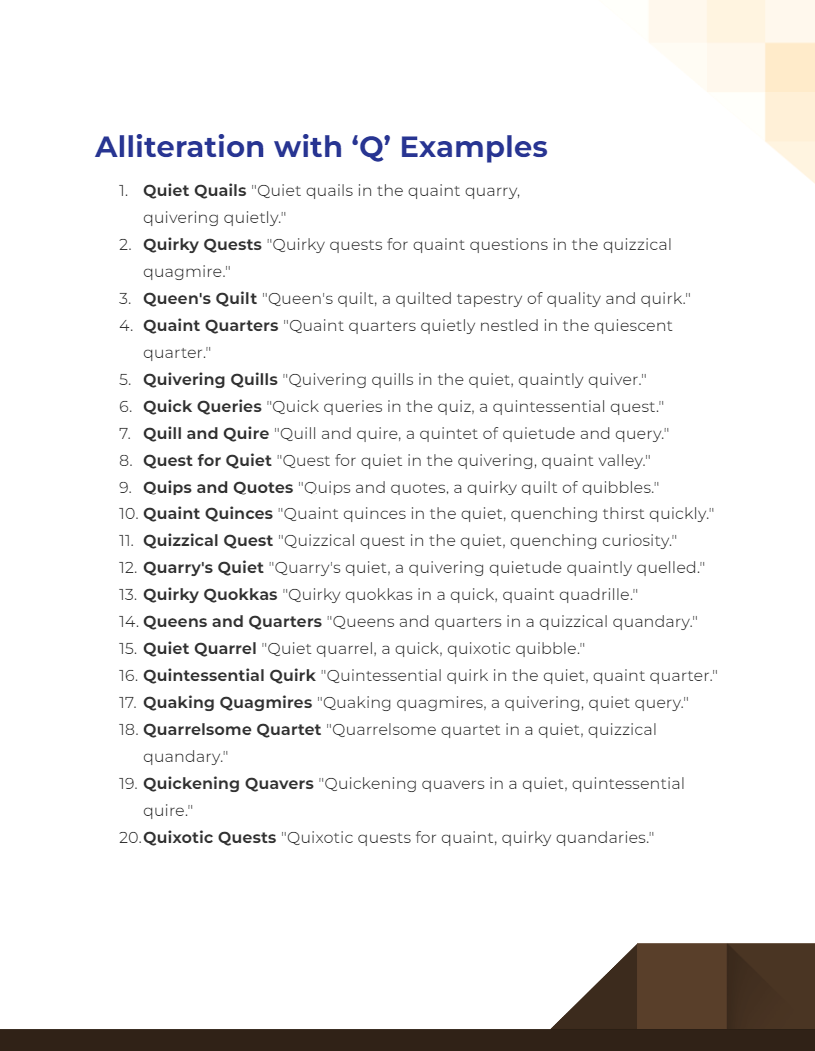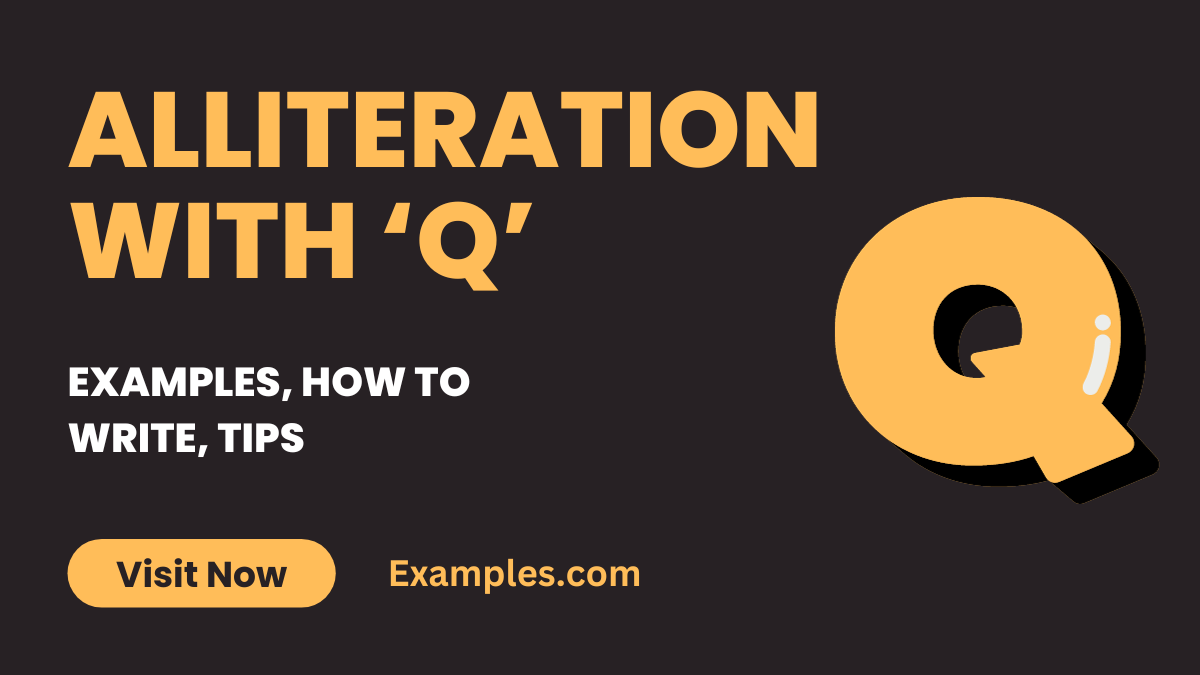19+ Alliteration with Q Examples
Alliteration with the letter ‘Q’ offers a unique challenge in English due to its less frequent use. However, this rarity can be turned into an asset, making ‘Q’ alliterations quite striking and distinctive. Using ‘Q’ for alliteration often brings a quirky or quaint quality to the text, lending it an air of sophistication or whimsy. When writing alliterations with ‘Q,’ the key is to find words that not only start with the letter but also contribute to the overall meaning and rhythm of the sentence. This can enhance the text’s memorability and impact. Whether used in creative writing, branding, or poetic expression, ‘Q’ famous alliterations can be a powerful tool for adding a unique and engaging twist to language.
Download Alliteration with 'Q' Examples
Download Alliteration with 'A' to 'Z' Examples
What is the Best Example of Alliteration with ‘Q’?

Example: A classic example of alliteration with the letter ‘Q’ is the phrase “Quick brown fox jumps.”
Meaning: Alliteration is a literary device where consecutive words in a sentence or phrase begin with the same consonant sound. However, finding words that start with ‘Q’ can be challenging, so examples are relatively rare. In the phrase “Quick brown fox jumps,” the repetition of the ‘Q’ sound at the beginning of “Quick” and “brown” illustrates alliteration. Despite the limited availability of ‘Q’ words, easy alliteration with this letter can still be used for creative and memorable effects in writing and poetry.
20 Alliteration with ‘Q’ Examples

Download Alliteration with 'Q' Examples in PDF
Alliteration with the letter ‘Q’ crafts a quintessence of quirky and quaint quips, bringing a unique quality to language. The ‘Q’ sound, known for its distinct and sometimes quirky tone, is perfect for creating both easy and hard alliteration examples. Particularly effective in alliteration in rhymes, the ‘Q’ sound adds a rhythmic and engaging quality to verses. Here are 20 unique examples of alliteration with ‘Q’, each accompanied by a rhyme title that captures the essence of the phrase.
- Quiet Quails “Quiet quails in the quaint quarry, quivering quietly.”
- Quirky Quests “Quirky quests for quaint questions in the quizzical quagmire.”
- Queen’s Quilt “Queen’s quilt, a quilted tapestry of quality and quirk.”
- Quaint Quarters “Quaint quarters quietly nestled in the quiescent quarter.”
- Quivering Quills “Quivering quills in the quiet, quaintly quiver.”
- Quick Queries “Quick queries in the quiz, a quintessential quest.”
- Quill and Quire “Quill and quire, a quintet of quietude and query.”
- Quest for Quiet “Quest for quiet in the quivering, quaint valley.”
- Quips and Quotes “Quips and quotes, a quirky quilt of quibbles.”
- Quaint Quinces “Quaint quinces in the quiet, quenching thirst quickly.”
- Quizzical Quest “Quizzical quest in the quiet, quenching curiosity.”
- Quarry’s Quiet “Quarry’s quiet, a quivering quietude quaintly quelled.”
- Quirky Quokkas “Quirky quokkas in a quick, quaint quadrille.”
- Queens and Quarters “Queens and quarters in a quizzical quandary.”
- Quiet Quarrel “Quiet quarrel, a quick, quixotic quibble.”
- Quintessential Quirk “Quintessential quirk in the quiet, quaint quarter.”
- Quaking Quagmires “Quaking quagmires, a quivering, quiet query.”
- Quarrelsome Quartet “Quarrelsome quartet in a quiet, quizzical quandary.”
- Quickening Quavers “Quickening quavers in a quiet, quintessential quire.”
- Quixotic Quests “Quixotic quests for quaint, quirky quandaries.”
Alliteration Sentence Examples with ‘Q’
Alliteration sentence examples with ‘Q’ often exude a quaint and quirky quality, using the unique ‘Q’ sound to create rhythm and emphasis. This type of alliteration is popular in various forms of literature, including alliteration in poems, songs, and movies, where it adds a distinct character to the narrative. Here are three examples:
- “Quincy’s quokka quickly quaffed the quart of quince juice.”
- “Quinn’s quirky quips quelled the quarrelsome crowd.”
- “The queen’s quest for quietude quickly became quite a quandary.”
Alliteration Examples with ‘Q’ Words
Alliteration examples using ‘Q’ words demonstrate the effectiveness of this consonant in creating resonant, memorable phrases. Employed for its unique quality in alliteration in songs, the ‘Q’ sound adds a distinctive element. Here are three examples:
- “Quietly questioning the quizzical quandaries of quantum physics.”
- “Quinton’s quill quivered quaintly as he quickly quoted the quatrains.”
- “A queue of quirky quails quibbled over quinoa.”
Alliteration Poem with ‘Q’
An alliteration poem with ‘Q’ employs the repetitive ‘Q’ sound to create a rhythmic and engaging poetic experience. Alliteration in poems, especially with the ‘Q’ sound, brings a unique lyrical quality. Here are three examples:
- “Quiet queen of the quay, / Quelling qualms in a quaint way.”
- “Quirky quokkas in a queue, / Quaffing quince under the blue.”
- “Quaintly questing in the night, / Quixotic quests take their flight.”
Alliteration Starting with ‘Q’
Alliteration beginning with ‘Q’ sets a specific tone and rhythm in a phrase, often creating a memorable and impactful auditory experience. Found in various artistic expressions, including alliteration in movies, it adds a distinct flair. Here are three examples:
- “Quickly, the quail quivered in the quiet glade.”
- “Quincy’s quest led him to a quaint, quiet village.”
- “Quivering quietly, the quaint quince tree stood in the quad.”
How to Write Alliteration with ‘Q’?
Writing alliteration with the letter ‘Q’ involves the creative placement of words that start with the ‘Q’ sound in close sequence within your sentences or phrases. The ‘Q’ sound, known for its unique quality, can add a quirky and distinct rhythm to your writing. This technique is versatile and can be used across various contexts, including educational content like alliteration for first grade and more sophisticated alliteration in figurative language compositions. Here’s how to craft effective alliteration with ‘Q’:
- Understand the ‘Q’ Sound: Familiarize yourself with the ‘Q’ sound, which typically requires a ‘u’ to follow it (as in “queen” or “quest”). It’s a less common sound, making it unique in alliteration.
- Choose a Theme or Concept: Select a theme or subject. This helps in selecting ‘Q’ words that are relevant and appropriate for your context, whether you’re crafting alliteration with answers or for creative expression.
- Brainstorm ‘Q’ Words: Compile a list of words that start with ‘Q’. Include different types of words (nouns, verbs, adjectives) to enhance your alliteration.
- Create Your Phrase or Sentence: Arrange your ‘Q’ words to form a coherent and rhythmic sentence. Aim for a natural flow that emphasizes the alliterative effect.
- Read Aloud for Rhythm: The effectiveness of alliteration is best judged audibly. Read your sentence aloud to ensure it flows well and the ‘Q’ sound is pronounced clearly.
- Revise for Clarity and Impact: Make sure your alliterative phrase is clear and contributes effectively to your overall message or story.
- Apply in Various Contexts: Adapt your use of ‘Q’ alliteration to suit the purpose and audience, whether it’s in alliteration figurative language exercises, as part of teaching alliteration for first grade, or in creative writing.
Tips for Using Alliteration with ‘Q’
Here are the Tips for Using Alliteration with ‘Q’:
- Use Sparingly: Given the unique nature of the ‘Q’ sound, use it judiciously to avoid making your text feel forced or unnatural. Employ it to emphasize key points or add a distinctive flair.
- Maintain Clarity: Your primary goal is to convey a message clearly. Alliteration should complement, not overshadow, your narrative.
- Consider Word Variety: Since ‘Q’ words are not as abundant as other letters, be creative in using a variety of words and forms. This is particularly important in alliteration for first grade, where simplicity is key.
- Embrace the Quirkiness: The ‘Q’ sound naturally lends itself to quirky and unusual phrases. Embrace this in your writing to add character and interest.
- Read and Revise: Reading your work aloud helps you assess the rhythm and flow. Adjust as needed to ensure the alliteration is effective and enhances the text.
- Suitable for Audience: Tailor your alliteration to your audience. For alliteration for first grade, opt for simpler and more playful phrases than you would for alliteration for adults.
- Explore Different Forms: Experiment with ‘Q’ alliteration in various forms of writing, from poetry and stories to advertising and academic work, to understand its effect.
Remember, the key to effective alliteration with ‘Q’ is balancing its unique sound with readability, ensuring that the alliterative phrases add value to your writing.
What are the Alliteration with ‘Q’ for Kids?
Alliteration with ‘Q’ for kids typically involves playful and quirky phrases that are easy to understand and recite. These alliterations are great for engaging children in language learning, helping them with phonetics, and making the learning process enjoyable. Here are three examples specifically designed for alliteration for kids:
- “Quincy the quail quietly questioned the quirky queen.”
- “Quinn’s quick quokka quickly quenched its thirst.”
- “Quincy’s quacking ducks queued quietly for quiche.”
These examples are tailored to be fun and memorable for children, aiding in language development and literacy skills.
What is the Effect of ‘Q’ Letter in Alliteration?
The effect of the ‘Q’ letter in alliteration is to create a distinct, somewhat quirky sound that can add a unique rhythmic and often playful quality to the text. The ‘Q’ sound is less common than other consonants, which can make it stand out in language. In alliteration literature, ‘Q’ alliteration is often used to draw attention to specific phrases, to set a particular mood, or to add a rhythmic quality to the text. Its uniqueness makes it suitable for all audiences, from alliteration for kids to more sophisticated literary works for adults. The ‘Q’ sound is significant in both alliteration and assonance, contributing to the overall sonic appeal of a piece.
What is the Alliteration ‘Q’ Type of?
Alliteration with the letter ‘Q’ is primarily a type of consonantal alliteration, where the consonant sound at the beginning of adjacent or closely connected words is repeated. It’s a common and effective literary device used across various forms of writing. The ‘Q’ type of alliteration can create different effects, from quirky and light to more pronounced and distinctive, depending on the context and the words chosen. This form of alliteration is seen in a wide range of contexts, from educational materials like alliteration for students to more complex literary compositions for adults. It is often used in conjunction with alliteration and assonance exercises to explore the sonic qualities of language. The ‘Q’ type of alliteration is appreciated for its ability to add a rhythmic quality to writing, enhancing its impact and memorability.



